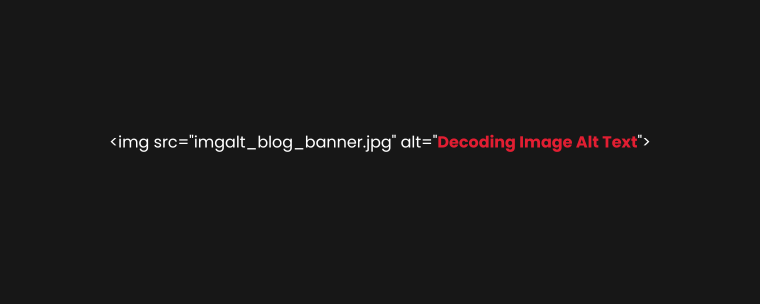Image Alt, SEO
Decoding Image Alt Text: The Unsung Hero of SEO
SEO, as we know it, is constantly changing and evolving. In such a dynamic field, staying stagnant is like spotting a shapeshifter or Sasquatch – nearly impossible.

In such a trial-and-error-based field like digital marketing, strategies are key and strategies require tools, a whole arsenal in fact. While boxing yourself to the limits of just keywords, backlinks, and content quality, with a conservative approach, underutilizing or avoiding to try out tools like alt text, is a point of view that is parochial nonetheless.
Let’s dive deep into the moshpit and understand what are the possibilities with ‘alt text’
Be water, my friend.
What is Image Alt Text?
Alt text, or alternative text, is a brief description of an image embedded in the HTML code of a webpage using the ‘alt’ attribute of the ‘<img>’ tag. It serves not only to describe the content and function of images for visually impaired users using screen readers and provides context to search engines, but also to improve the accessibility, and readability for all users.
Additionally, alt text acts as a fallback if an image fails to load, displaying the description in place of the image.
Why is it important?
1. Improved Search Engine Understanding
By providing clear and descriptive alt text, you help search engines understand what the image is about. This can contribute to better indexing and ranking of your web pages.
2. Better UX
Good alt text can help better the experience for users with visual impairments, making your site more accessible and readable. Accessibility is not just a legal and ethical consideration but can also positively impact your SEO, as search engines prioritize user – friendly websites.
3. Increased Traffic Through Image Search
Optimised alt text can improve the chances of your images appearing in the image search results, driving more traffic to your site.
4. Contextual relevance
Alt text can reinforce the relevance of your content, as it provides additional context that supports the primary keywords and topics of your web pages.
Pitfalls to avoid -
While some images may be purely decorative, most should have alt text. Even decorative images should have empty alt text (‘alt=””’) to indicate that they can be ignored by screen readers.
Keyword stuffing in alt text can be counterproductive. It can lead to a poor user experience and potential penalties from search engines. So avoiding that would be the best solution.
Alt text with descriptions like “Image1” or “Picture” doesn’t help. Be specific about what the image depicts.
While purely decorative images should have empty alt attributes, overlooking them entirely can confuse screen readers. Always use (‘alt=””’) for decorative images.
Image alt text is an underrated, underutilized aspect of Search Engine Optimization (SEO). By providing clear, descriptive, and relevant alt text, you can improve your site’s accessibility, up the user experience, and also boost SEO efforts. In a landscape as competitive as this, stepping away from conventional methods would be the secret ingredient in your recipe.
Recent Posts
- Marketing Is No Longer About the Stuff That You Make, but About the Stories You Tell
- Social Media Marketing in 2026: Platforms, Trends & Engagement Tactics
- SEO in 2026: Winning Strategies for the AI-Driven Search Era
- How Small Businesses Can Leverage Digital Marketing in 2026
- Emerging Digital Marketing Trends That Will Redefine 2026



